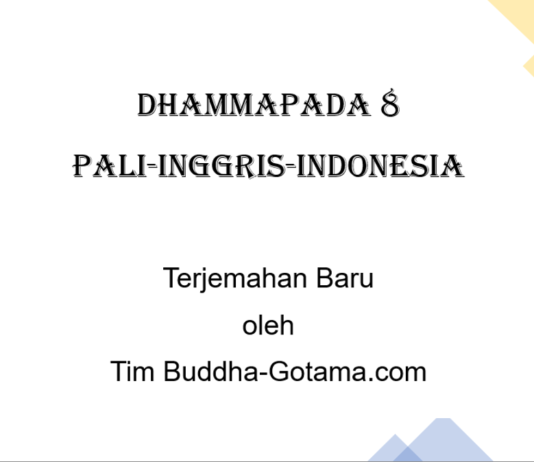Yamaka Vagga



Vocabulary 1 |
Vocabulary 2 |
viharantaṁ: viharati (3rd pers.sg. pres. indic. act. of vi- (pf. ‘away,’ opposite of the prefix saṁ) + √har ‘carry’ = lives; viharanta (pres.part. of viharati) = living; viharantaṁ (sg. masc. acc.) = livingindriyesu: indriya (nt.) = sense organ; indriyesu (pl. loc.) = in sensesbhojanamhi: bhojana (nt.) = food; bhojanamhi (sg. loc.) = in foodsaddhaṁ: saddha (adj.) = having confidence in, trusting; saddhaṁ (sg. masc. acc.) = having confidence in, trustingāraddhavīriyaṁ: consisting of āraddha (adj. past part. of ā (pf. denoting a close relationship to the object or the aim of action expressed in the verb) ‘firm, resolved, or resolute’ + √rabh ‘to grasp, to take hold of’; viriya (nt.) = energy; āraddhavīriya (adj. here vīriya is m.c. for viriya) energetic, with a firm effort; āraddhavīriyaṁ (sg. masc. acc.) = energetic |
taṁ (sg. masc. acc. of the demonstr pron. ta ‘it, that’ = it, that, himve ( aff. part. emphasizing the preceding word) = truly, indeedna-ppasahatī: na ( part.) = no, not. pasahati (3rd pers.sg. pres. indic. act. of pa- ( strengthening pf. often used to emphasize the intensity of an action) +√sah ‘overcome’ = overcomes. pasahatī is m.c. for pasahati; na +pasahatī = na-ppasahatī = cannot overcomemāro: māra (masc.) = Māra, the Evil One. māro (sg. nom.) = Māravāto: vāta (masc.) = wind. vāto (sg. nom.) = windselaṁ: sela (adj. masc.) = rocky. selaṁ (sg. acc.) = rockyva (encl.) = likepabbataṁ: pabbata (masc.) = mountain. pabbataṁ (sg. acc.) = mountain |
Pali Grammar
- Inseparable Prefixes
1.1 Duroiselle (1915/1997:138) writes
(a) Like du- and su-, the prefix a- (or an before before a vowel) ‘not, without, free from, non,’, e.g., abhāya ‘, safe, free from fear or danger;’ abāla’ clever, not foolish;’ apassanto ‘not seeing;’ anāloketva ‘without looking,’ belongs to the class of inseparable prefixes:
du- and before a vowel dur-, ‘bad, ill, hard difficult,’ e.g. dubbaṇṇo, ugly, ill-favoured; dubbinīto ‘ill-conducted;’ duddamo ‘difficult to tame;’ duggo ‘difficult to pass;’ dujjano ‘a bad man;’ dukkaro ‘difficult to perform;’ dujjīvaṁ ‘a hard life.’
(b) su has the contrary meaning of du :good, well, easy. It implies excess, facility, excellence.
e.g. subhāsito, well-spoken; subahu, very much; sudanto, well-tamed; sukaro, easy to perform; sulabho, easy to be obtained.
Remarks: After du, the initial consonant is generally reduplicated; reduplication seldom takes place after su.
1.1.1 Warder (2014:236) also writes that a consonant is usually doubled after the prefixes u(d) and (dur); similarly the r of ni(r) is assimilated:
du(r) + caritaṁ > duccaritaṁ
u(d) + pajjati > uppajjati
ni(r) + pītika > nippītika
m(r) + yā > niyyā
1asubhānupassiṁ:* (a) not contemplating pleasant things or pleasures, who is not contemplating pleasant things or pleasures; (b) formation: either from (1) the addition of the prefix a- ‘not, no’ to (sg. 3rd pers. masc. acc. adj. and substantive) subhānupassiṁ ‘contemplating pleasant things or pleasures, who is contemplating pleasant things;’ (b) subhānupassiṁ; from subhānupassī ‘(one) contemplating pleasant things;’ + -ṁ, a masc. acc. suffix for a sg. 3rd. person or an adjective modifying a sg. 3rd pers.; (c) subhānupassī: from subhānupass ‘to contemplate pleasant things or pleasures’ + -ī** (producing a masc. noun); (d) subhānupass: from subha ‘pleasant’ + anupass ‘to contemplate,’ with the usual elision or suppression*** of the final a and the lengthening of the initial a (or subh + ānupass); (d) anupass: from anu- (pf.) ‘along, at, on, in, down, to, following, combined with’ +√pass ‘to see;’
*asubhānupassiṁ: (i) ambiguous meanings: either (who is) not contemplating pleasant things or pleasures or (who is) contemplating unpleasant things, because asubha means ‘unpleasant, disgusting;’ (ii) the context decides;
**the new possessive suffix –ī or the old -in (Geiger & Norman, 2005: § 95, p.88; Duroiselle, 1915/1997:143), sometimes used substantively, as in the present stanza (Duroiselle, ibid.)
*** (i) Duroiselle (1915/1997:7, No. 17) calls it the elision of the final a in subha and the lengthening of the initial a in anupassī; (ii) Clough (1824:14) calls it the suppression of of the final a in subha and the lengthening of the initial a in anupassī; (iii) and (iii) Perniola (1915/1997:8, No.6(a)) calls is contraction. He also writes that when a vowel is in a closed syllable, it cannot be long: lāla+ antare > kālantare.
Sometimes, however, in the formation of compounds, there is a long vowel in a closed syllable: sa-+ attha > sāttha ‘with its meaning;’ sa-+ akhara > sākkhara ‘with its letters.’
–Iklan–

Untuk informasi lebih lanjut tentang manfaat dan pentingnya fang sheng, silahkan klik: https://www.buddha-gotama.com/2023/06/28/buah-lebat-fang-sheng-pengikisan-kilesa/
2.1viharantaṁ: (a) (sg. masc. acc.) living, one who, or what, lives; (b) formed from viharanta (adj. & present participle of the stem vihara ‘to live’ + -ntaṁ; (c) vihara is the stem of viharati ‘(she, he, it, or one) lives,’ which belongs to the verbs of the first class which form their stems by adding the suffix -a to the roots: vihar ‘to live’ + -a; (d) vihar is derived from vi- + ‘away, also denoting the reverse of the simple verb, or loss, difference, opposite, reverse, as expressed in English by un- or dis-,’ + √har ‘to carry.
(Perniola (2004:75, No.62) writes that in the formation of the present stem, the final vowel of the root or a medial short vowel takes the guṇa grade (strengthening or adapting):
ni- ‘to lead’ ne-a-ti > nay-a-ti > nayati
bhu- ‘to be’ bho-a-ti > bhav-a-ti > bhavati
har- ‘to carry’ har-a-ti > harati
mud- ‘to delight’ mod-a-ti > modati
but the vowel -a and any medial vowel which is long either by nature or position remain unchanged:
vah- ‘to carry’ vah-a-ti vahati
jīv- ‘to live’ jīv-a-ti jīvati
hims- ‘to hurt’ hims-a-ti himsati
nind- ‘to blame’ nind-a-ti nindati
In verbs like nayati, bhavati, the groups aya/ava may be contracted to e/o, respectively: nayati > neti; bhavati > bhoti > hoti, with the loss of the consonantal sound ….;
(e) Duroiselle (idem., p.101, No. 446) These participles are conjugated like mahā (226) in the Masculine, Feminine and Neuter. The Present Participle may often be translated by “when …, while …”etc.; (f) Ānandajoti (2016:10) writes that the ending of the sg. masc. accusative case of the present participle parassapada of nt/nta forms is ntaṁ, as in gacchantaṁ, and the ending of the pl. masc. accusative case of the same parassapada is gacchante; hence, the parassapada above is conjugated like a noun ending in -a; (g)(i)Thitzana [in Kaccāyana Pali Grammar, No. 186.107, Volume 2 (2016), translated by Thitzana] writes that the affix -nta* of the word gacchanta etc. sometimes changes into “aṁ” when a si* vibhatti** is applied after them.
See each pairs of examples. Both “aṁ and anto” are shown in bold so that students can easily distinguish between the applied example and inapplicable examples. The second one *marked is inapplicable example:
gacchaṁ, * gacchanto (sg. masc. nom.) = the one who goes, while going
mahaṁ, * mahanto (sg. masc. nom.) = the one who is great or honorable
caraṁ, * caranto (sg. masc. nom.) = the one who goes, while going
khādaṁ, * khādanto (sg. masc. nom.) = the one who munches, while munching.
Hence, viharantaṁ means (sg. masc. acc.) the one who lives.
*ntasaddo: refers to those nouns affixed with -nta affix. This nta is the last component part of -anta affix applied by Sutta No. 565 which is widely used as a present participle affix for many Kita nouns. Ntasaddo means any noun affixed with -anta but note that the letter “a” is left out in this expression and simply stated as “ntasaddo”. [nta=nta, saddo=word].
**si: a symbol for any inflection to be described as nominative singular; it is not itself one of these inflections (which are very varied, so that no common denomination is apparent). It is as if one were to call it “x, explaining: “where “x” = any inflection described as “nominative singular.” In the case of -ti, this is the actual inflection of the third person singular active indicative present tense of all verbs. Thus in one sense there is only one “conjugation” of the active indicative present tense of Pali verbs, since all take the same set of inflections; the seven or eight conjugations distinguished by the grammarians are based on the differences of present stem formation from the roots. On the other hand, there are several “declensions” of nouns, since their inflections vary considerably according to their stems (in -a, -an, -ant, -I, -ar, etc.).
(ii)Declension of vi- + √har- + -nta = viharanta (= the present participle of the stem vihara) for its nominative and accusative cases as an adjective and agent noun or doer:
Cases Singular plural
Nom. viharanto/viharantaṁ harantā
Acc. viharantaṁ harante
[formed following Gair & Karunatillake (1998/2014:36)]
(h)Gair & Karunatillake (1998/2014:37) write that one use of the present participle is as an actor verbal noun denoting the doer of the action (or agent noun). In this use, it takes the masculine endings given above, if the doer is masculine, or if gender is unspecified:
evaṁ desento (bhabbo)
‘One who thus preaches (is competent)’
*Gair & Karunatillake (1998/2014:71-72) write that the past participle (sometimes called the perfect or the passive participle) is most commonly formed with one of the two affixes -ta or-na. Of these two, -ta is the most common…. Past participles may also, like the present participle, take gender and number endings to form nouns; in the case of the past participle, the noun will generally refer to the performer of the action (i.e., the subject of the verb) if the verb from which it is formed is intransitive, or the one who has undergone the action, i.e., the object of the verb, if the verb is transitive.* The gender number endings, and their case forms, are those of -a stem masculine and neuter (I, 1.21-2) and -ā stem feminine (11, 1.1) nouns. The form Tathagato (nom.) ‘the thus-gone one,’ used for the Buddha, is an example, being formed from gata, the participle of gacchati.
*For example, √vu means to restrain, a transitive verb; saṁ- + -vu+ -ta = saṁvuta restrained, one who, or what, is or was restrained; the opposite is asaṁvuta ‘unrestrained, one who, or what, is or was unrestrained.’
(This part is also found in the discussion about asaṁvutaṁ below.)
(i)Perniola (1997:282, No.225) writes that in Pali, all the parassapada of the present participle have the suffix -ant, in which the final dental (or t) drops and the -n is changed to niggahīta. The suffix -ant has often been extended with the thematic vowel and thus a new suffix -anta is often used in the formation of the present participle. In fact this suffix is the only one used when the present participle is formed from the stem of the present ending in -e or -o: cintenta, karonta. Hence, vi- + √har + -anta > viharanta, the parassapada of the present participle;
(j) About the present participle, Duroiselle (idem., p.100, Nos.439-440) writes that (i) all active participles are of the nature of verbal adjectives and must agree with their nouns, in number, gender and case; and (ii) The terminations of the present participle active are nta, aṁ, or ṁ; -nta and ṁ are added to the base (or stem), and aṁ is added to the root.
Examples:
Root Base Present. Part. Active Base
√pac, to cook, paca pacaṁ, pacanta cooking
√kar, to do, kara karaṁ, karonta doing
√chid, to cut, chinda chindaṁ, chindanta cutting
√bhaṇ, to say, bhaṇa bhaṇaṁ, bhaṇanta saying
√bhū, to be, bhava bhavaṁ, bhavanta being
√pā, to drink, piva pivaṁ, pivanta drinking
2.2indriyesu: (a) (pl. loc.) on, in, or among sense organs; (b) euphonic union, or sandhi of indriya + -su (a pl. loc. nt. suffix), with the final a changing to e, as written by [Duroiselle, idem., p. 27(h)]. Another example: butha ‘being’ + -su > buthesu (see stanza 59).
2.3susaṁvutaṁ: (sg. masc. adj. acc.) ‘well-restrained, one who, or what, is or was well-restrained; (b) union of su- (pf. ‘well, thorough’) + saṁ* (adj. pf.) ‘denoting conjunction, completeness’ + vuta (past part. of √vu ‘to restrain’) ‘restrained;’
*saṁ- or saṃ-, an indeclinable prefix to verbal roots:* (1) implying a conjunction, e.g., with, together;’ (2) denoting (i) ’completeness,’ (opposite vi-):
(a)Duroiselle (1915/1997:14, No. 38) writes that the niggahīta when followed by a consonant may remain unchanged.
Examples:
(v) taṁ dhammaṁ kataṁ; (ii) taṁ khaṇaṁ; (iii) taṁ patto
(b) Nasal-nasal: a nasal consonant (ń, ñ, ṇ, n, or m) followed by another nasal consonant, is assimilated to the latter: saṁ-nisīdati > sannisīdati ‘he sinks down’ (Perniola, 2001:23, No.15(a);
a.1sam-: (a) before a labial (b, bh, m, p, or ph) [(i) thus forming nasal-nasal (Perniola, idem.) (ii) niggahīta, followed by a consonant, may be transformed into the nasal of the class to which that consonant belongs (Duroiselle, idem., p. 14, No.39)]: Sambuddha* (saṁ- + buddha), sampajāna ‘attentive, mindful, thoughtful, deliberate’ (saṁ + pajāna ‘understanding, distinguishing’)
(b) before a vowel: samativijjhati, derived from saṁ– +ativijjhati ‘(it) penetrates,’ samacchati ‘(she, she, or it, or one) sits together,’ derived from saṁ- + acchati ‘(she, he, it or one) sits
*Sambuddha: (a) saṁ- + buddha, which is derived from budh ‘to enlighten’ + -ta (a past participle suffix; if formed from a transitive verb, it makes a passive meaning ; otherwise, it forms an active meaning) = budhta > buddha ‘enlightened.’ This is as written by Perniola [idem., p. 17, No.13(a)] that when two mute consonants come together, the first is assimilated to the second since both are of the same strength:
yuj-ta > yutta ‘joined’
mad-ta > matta ‘intoxicated’
tadkāro > takkāro ‘he who does that’
sat-puriso > sappuriso ‘good man.’
The consonant t, however, preceded by one of the soft aspirate consonants gh, dh, or bh, is first shortened to d and then assimilation takes place:
labh-tum > labh-dum > laddhum ‘to bobtain’
lubh-ta > lubhda > luddha ‘greedy’
budh-ta > budh-da > buddha ‘enlightened ;’
(b) Duroiselle (ibid.,p 18, No.63) writes that when initial t follows a sonant aspirate (gh, jh, ḍh, dh, or bh), the assimilation is progressive: the final sonant aspirate loses its aspiration, the following t (surd) becomes sonant, viz. d, and, taking the aspiration which the final sonant has lost, becomes dh:
EXAMPLE:
√rudh+ta=rudh+da=rud+dha=ruddha
a.2saṁ– before (i) a surd (or sibilant) (s), labial (b, bh, m, p, or ph), or glide (or semi-vowel) (y,* or v):, e.g., saṁsara, Saṁbuddha,* saṁyojana,b saṁyutta;b

Remark: In the case of final bh, initial t having become dh, regressive assimilation takes place: √labh + ta = labh + da = lab + dha = laddha ‘(having) taken, obtained, received;’ (labhati ‘obtains, takes, receives’)
a.2.1 by assimilation, also san– before a dental (d, dh, t, th, or n), e.g., santapeti, sandahati;
a.3saṅ– or saṇ: (a) before a guttural (or velar) (k, kh, g, gh, and ṅ) or aspirate (h), e.g., (i)saṅgha ‘assembly, community, brotherhood, sisterhood, order, or a chapter of a certain Buddhist order, or a certain number of monks;’ (ii) saṅkhāra, saṅkhata, asaṅkheyya; (iii) saṇha ‘smooth, gentle, mild,’ (Andersen, 1907/2020:253); saṇheti ‘to brush down’ (Davids & Stede 1921-1925/2005, Part VII, p.131);’ (b) before retroflex, or cerebral: ḍ, ḍh, ṭ, ṭh, or ṇ: saṁ+ṭhiṭṭhati > saṇṭhiṭṭhati ‘stands;’ saṁ+ṭhānaṁ > saṇṭhānaṁ ‘position’ (called as assimilation or adaptation by Perniola, 1997:14, No. 11(b)]
a.4sañ- (i) before a palatal (c, ch, j, jh, or ñ), e.g., sañcarati [also found in Perniola, 1997:14, No.11(b)], sañchidati ‘to cut, ‘to destroy,’ sañjāti ‘birth, origin, outcome;’ sañjagghati ‘to joke,’ sañña ‘perception,’ viññū ‘intelligent, wise, learned, knowledgable;’ (ii) before a word beginning with e and the ñ, the initial e changes into ññ: taṁ+eva= taññeva, paccantaraṁ+eva= paccantaraññeva; (iii) before a word beginning with h: evaṁ hi kho= evañhi kho, taṁ+hitassa= tañhitassa (Duroiselle,1915/1997:14, No.40) [see also a.3(iii)];
a.5(i)sal- before the liquids l, ļ or ļh, e.g., sallakhetti ‘to observe,’ sallapati ‘to talk with;’ sa-before the liquid r, sometimes sā-, e.g., sāratta, sārambha (Davids & Stede 1921-1925/2005, Part IV:114, Geiger & Norman, 2005, § 74.3, & the present author’s own research);
(ii) Before initial l, the niggahīta of saṁ and puṁ is changed to l:
(i) saṁ+lakkhaṇā=sallakkhaṇā; (ii) paṭi saṁ līno=paṭisallīno; (iii) saṁ+lekko=sallekho (Duroiselle, 1915/1997:14, No.39); (iv)
puṁ+ligaṁ=pulligaṁ (idem., No.39);
a.6 Duroiselle( idem., No.39) writes that the niggahīta, when followed by a consonant, may be transformed into the nasal of the class to which that consonant belongs.
EXAMPLES with (the explanatory notes in the parentheses being added by the present author):
(xvii) raṇaṁ+jaho=ranañjaho (ñ belongs to the guttural (or velar) consonant class or group, consisting of g, gh, k, kh, and ń);
(xviii) taṇhaṁ+karo=taṇhańkaro;
(xix) saṁ+ṭhito=saṇṭhito (ṇ belongs to the cerebral or retroflex) consonant class or group, consisting of ṭ, th, ḍ, ḍh, and ṇ);
(xx) jutiṁ+dharo=jutindharo (n belongs to the dental consonant class or group, consisting of d, dh, t, th, and n);
(xxi) saṁ+mato=sammato (m belongs to the (bi-)labial consonant class or group, consisting of b, bh, p, ph, and m);
(xxii) evaṁ+kho=evań kho [see (i)];
(xxiii) dhammaṁ+ca=dhammañca (ñ belongs to the palatal consonant class or group, consisting of c, ch, j, jh, and ñ);
(xxiv) taṁ+niccutaṁ=taññiccutaṁ;
bsaṁ- + yogo: the niggahīta following y is assimilated into the y, and both together may become ññ: saññogo
saṁ- + yuttaṁ: saññuttaṁ
Often, no coalescence takes place, and both letters remain unchanged:
saṁyuttaṁ, saṁyojanaṁ (Duroiselle, 1915/1997:14, No.41).
Examples taken by the present author from the other stanzas of the Dhammapada:
31: saṁyojanaṁ >saññojanaṁ
37: saṁyamessanti > saññamessanti
*(Davids & Stede 1921-1925/2005, Part IV:114, Geiger & Norman, 2005, § 74.3, & Tjan’s own research)
Davids & Stede (ibid.) writes that saṁ- (or saṃ–) is the second most frequently (16%) used prefix in Pali after vi- (19%).
3mattaññuṁ: (a) knowing the right measure, i.e., knowing moderation; (b) euphonic union, or sandhi, of mattā (fem.) ‘(right) measure’ [In compounds as in this case, mattā is shortened to matta (Davids & Stede 1921-1925/2005, Part VI, p.141)] 3.1+ ñu (adj.) ‘knowing,’ + -ṁ, a suffix indicating sg. masc. acc., with the doubling of ñ, as written by Duroiselle (idem., p.13, No. 33) that a consonant (in this matter ñ) following a word ening in a vowel (matta) is generally reduplicated, e.g., kata ‘done, what is done’ + ñu = kataññu ‘grateful;’ (c) ñu is the present participle of √ña ‘to know;’
3.1 Duroiselle (idem, No.35) also writes that when, according to para (33), a consonant is reduplicated after a particle ending in a long vowel, this vowel is shortened:
ā+kamati=akkamati
parā+kamo=parakkamo
Exceptions: There are, however, a few exceptions to paras 34, 35. The following are the most common examples:
(i) na+añña=nāñña (ii) na+assa=nāssa
na+assu=nāssu (iv) kasmā+assa=kasmāssa,
(v) tatra+assa=tatrāssa (vi) sa+antevāsiko=sāntevāsiko
(vii) sa+atthi=sātthi (viii)vedanā+khandho=vedanākkhandho, etc.
4saddhaṁ/saddha: According to the Commentary:
unwavering (unshakable) faith in the Buddha, the Dhamma (the Doctrine) and the Saṁgha (the Buddhist Religious Order) and
faith or belief in kamma (action) and its results (Tin, 2003:4).
5The form here does not arise through sandhi; na is so closely associated with the verb it is modifying it becomes part of it, as we see frequently with the negative (Ānandajoti, www.ancient-buddhist-texts.net).
| English 1: Burlingame |
English 2: Buddharakhita |
| Whoever lives looking not for pleasure, exercising restraint over his senses.
Moderate in his enjoyments, endowed with faith, exerting the power of his will. Him Māra does not overpower, even as the wind does not overpower a mountain of rock. |
Just a strom cannot prevail against a rocky mountain, so Mara can* never overpower the man who lives meditating on the impurities, who is controlled in his senses, moderate in eating, and filled with faith and earnest effort.
*In English and Indonesian, this auxiliary verb should not be used, as this stanza refers to what is an eternal, or general, or universal truth [Hands, 2011:208, No. 410; Thomson & martinet, 1986:159, No. 173(A); https://byjus.com/question-answer/give-some-examples-of-universal-truth/] |
| Indonesia 1: BDG |
Indonesia 2: CDD |
| Ibarat angin yang takmampu merobohkan bukit karang, demikian pula Mara tidak mampu menguasai orang yang tak menjadi budak keindahan, yang inderanya terkendali dengan baik, yang tahu batas dalam makanan, dan yang penuh keyakinan serta sangat bersemangat. | Seseorang yang hidupnya tidak mencari kesenangan, yang inderanya terkendali, yang makan secukupnya, yang penuh keyakinan dan bersemangat. Sesungguhnya Māra tidak dapat menumbangkannya bagaikan angin tidak dapat menumbangkan sebuah gunung karang. |





